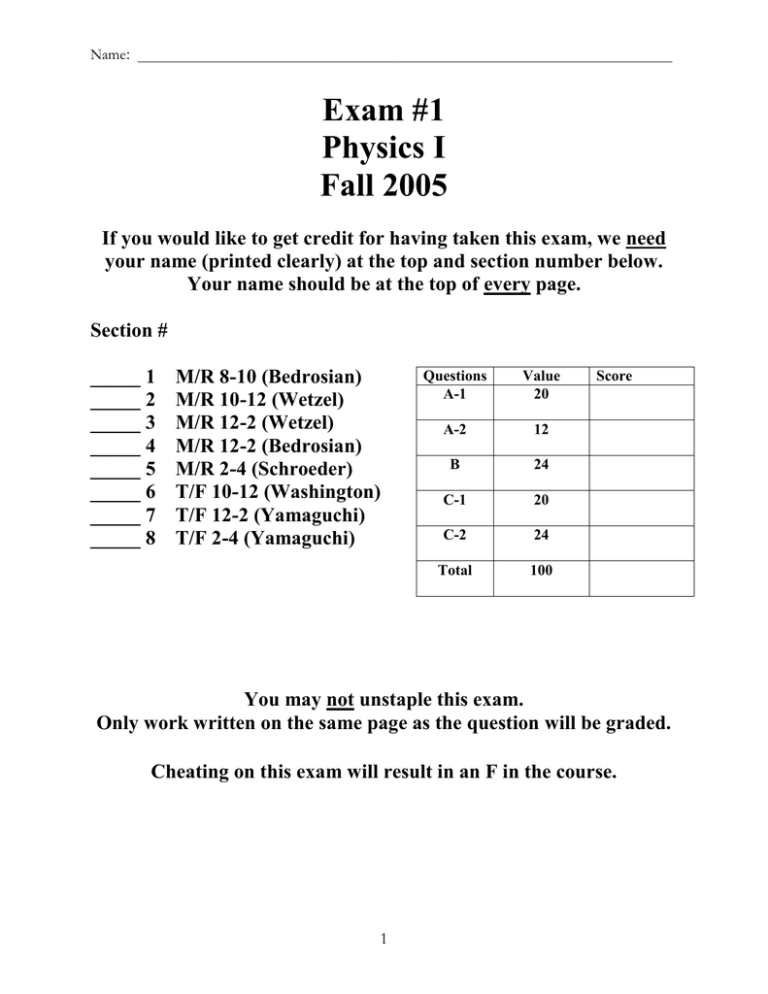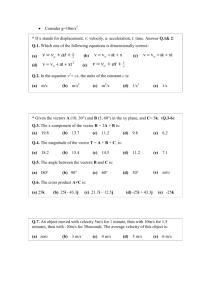Exam #1 Physics I Fall 2005
advertisement

Name: _______________________________________________________________________ Exam #1 Physics I Fall 2005 If you would like to get credit for having taken this exam, we need your name (printed clearly) at the top and section number below. Your name should be at the top of every page. Section # _____ 1 _____ 2 _____ 3 _____ 4 _____ 5 _____ 6 _____ 7 _____ 8 M/R 8-10 (Bedrosian) M/R 10-12 (Wetzel) M/R 12-2 (Wetzel) M/R 12-2 (Bedrosian) M/R 2-4 (Schroeder) T/F 10-12 (Washington) T/F 12-2 (Yamaguchi) T/F 2-4 (Yamaguchi) Questions A-1 Value 20 A-2 12 B 24 C-1 20 C-2 24 Total 100 Score You may not unstaple this exam. Only work written on the same page as the question will be graded. Cheating on this exam will result in an F in the course. 1 Name: _______________________________________________________________________ On this exam, please neglect any relativistic and/or quantum mechanical effects. If you don’t know what those are, don’t worry, we are neglecting them! On all multiple-choice questions, choose the best answer in the context of what we have learned in Physics I. On graphing and numerical questions (Parts B and C), show all work to receive credit. Part A1 – Multiple Choice – 20 Points Total (5 at 4 Points Each) Write your choice(s) on the line to the left of the question number. _______1. On the line to the left, write the equation number from the equation sheet that best expresses the Impulse-Momentum Theorem. _______2. An object is moving with a constant speed but changing direction. Which statement below is always true? A. B. C. D. The velocity of the object is constant. The acceleration of the object is zero. The acceleration of the object is constant. The acceleration of the object is at a right angle to its velocity. Questions 3-5 refer to the Atwood’s machine shown to the right with the masses released from rest and accelerating. The weight of the smaller mass is 3 N and the weight of the larger mass is 15 N. Assume the pulley and rope are ideal, meaning massless and frictionless. g is the acceleration constant of gravity, 9.8 m/s2. _______3. What is the magnitude of the tension in the rope when the masses are accelerating? A. 18 N. B. 15 N. C. 12 N. D. 9 N. ______ 4. 6 N. 5 N. 4 N. 3 N. 3N 15 N What is the acceleration (in the up direction) of the smaller mass? A. g. B. 2 g / 3. C. g / 2. ______ 5. E. F. G. H. D. g / 3. E. g / 4. F. g / 5. What is the acceleration (in the down direction) of the larger mass? A. g. B. 2 g / 3. C. g / 2. D. g / 3. E. g / 4. F. g / 5. 2 Name: _______________________________________________________________________ Part A2 – Multiple Choice – 12 Points Total (6 at 2 Points Each) For questions 6-11, refer to the graphs below. A brother threw his sister a ball. His sister caught the ball at the same height the brother let go of it. Let the +Y direction be up and the +X direction be horizontal from the brother to the sister. Assume the coordinates of the ball were (0,0) when the brother let go of it. Neglect air resistance. You must choose which graph represents each of the quantities given in questions 6-11. Put “0” as the answer if the quantity is zero for the entire time interval. A E 0 t (sec) 1.0 0 2.0 B t (sec) 1.0 2.0 1.0 2.0 1.0 2.0 1.0 2.0 F t (sec) 0 1.0 t (sec) 0 2.0 C G t (sec) 0 1.0 t (sec) 0 2.0 D H t (sec) 0 1.0 ______ 6. X (horizontal) displacement. ______ 7. X (horizontal) velocity. ______ 8. X (horizontal) acceleration. ______ 9. Y (vertical) displacement. t (sec) 0 2.0 ______ 10. Y (vertical) velocity. ______ 11. Y (vertical) acceleration. 3 Name: _______________________________________________________________________ B – Graphing – 24 Points This question involves two-dimensional motion. An object begins at rest and is subject to the net forces shown below in the X and Y directions, respectively, over the time interval (0,2) seconds. Plot the resulting momentum of the object (px and py) over the (0,2) second time interval. Make sure to include the following features – they should be clearly shown on your graphs: 1. General shapes of the curves, noting any points where the curvature or slope changes. 2. The values of px and py at t = 0, 1, and 2 seconds. Show all work. Fx (N) Fy (N) 2 2 1 1 0 t (sec) 1.0 0 t (sec) 2.0 1.0 px 2.0 py t (sec) 0 1.0 t (sec) 0 2.0 1.0 4 2.0 Name: _______________________________________________________________________ Problem C-1 (20 Points) A classroom projectile launcher is mounted on a table so that when the ball is launched it is 1.00 meters above the floor. The ball is launched at a speed of 3.00 m/s at an angle of 30° above the horizontal at a wall that is 1.50 meters away horizontally. How far above the floor does the ball hit the wall? Ignore air resistance and use g = 9.8 m/s2. wall v0 = 3.00 m/s = 30° d = 1.50 m h0 = 1.00 m h=? floor Height above floor = ______________________________________________ m 5 Name: _______________________________________________________________________ Problem C-2 (24 Points) A hockey puck sliding on frictionless ice at 10.0 m/s in the +X direction hits a second hockey puck of the same mass that is initially at rest. After the collision, the first puck is moving at speed V1 at an angle of +30° from the X axis. The second puck is moving at speed V2 at an angle of –60° from the X axis. Find V1 and V2. before puck 1 v0 = 10.0 m/s Y puck 2 (at rest) X after v1 = ? +30° puck 1 -60° puck 2 v2 = ? V1 = _______________________________________ m/s V2 = _______________________________________ m/s 6 Name: _______________________________________________________________________ Formula Sheet for Homework and Exams – Page 1 of 2 U Fcons dx 1. v v 0 a t t 0 23. 2. x x 0 v 0 ( t t 0 ) 12 a ( t t 0 ) 2 24. U g m g (y y 0 ) 3. x x 0 12 ( v0 v)( t t 0 ) 25. U s 12 k ( x x 0 ) 2 4. x x 0 v( t t 0 ) 12 a ( t t 0 ) 2 26. 27. 28. K U Wnoncons s r v tangential r 29. a tangential r 6. v 2 v 02 2a x x 0 F Fnet m a 7. T 8. a centripetal 5. 9. 10. 11. 12. 13. 14. 15. 16. 17. 18. 19. 20. 2r v v2 2 r r a radial a centripetal p mv dp F F net dt J Fnet dt p P pi dP Fext dt 30. 0 t t 0 31. 0 0 ( t t 0 ) 12 ( t t 0 ) 2 32. 0 12 (0 )( t t 0 ) 33. 0 ( t t 0 ) 12 ( t t 0 ) 2 2 02 2 0 35a. a b a b sin( ) a b a y b z a z b y î 35b. a z b x a x b z ĵ a x b y a y b x k̂ 34. 36. 37. M mi 38. 1 1 x cm m i x i y cm m i y i M M P M v cm a b a b cos() a x b x a y b y a z b z W Fd W F dx 21. K 12 m v 2 12 m (v x v y ) 22. K f K i Wnet 2 39. 40. 41. 42. 43. 2 I m i ri 2 K rot 12 I 2 W d r F dL I d t l r p L l i L I 44x. m1 v1, x ,before m 2 v 2, x ,before m1 v1, x ,after m 2 v 2, x ,after 44y. m1 v1, y ,before m 2 v 2, y ,before m1 v1, y ,after m 2 v 2, y,after 44z. m1 v1,z ,before m 2 v 2,z ,before m1 v1,z ,after m 2 v 2,z ,after 45a. v1,f m1 m 2 2 m2 v1,i v 2 ,i m1 m 2 m1 m 2 45b. 7 v 2,f 2 m1 m m1 v1,i 2 v 2 ,i m1 m 2 m1 m 2 Formula Sheet for Homework and Exams – Page 2 of 2 46a. 46b. 47a. 47b. 48a. 48b. 49. m m | F | G 1 2 2 r m m F G 1 2 2 r̂ r 1 | q1 || q 2 | | F | 4 0 r2 1 q1 q 2 F (r̂ ) 4 0 r 2 1 | qi | | Ei | 4 0 ri 2 1 qi E (r̂i ) 4 0 ri 2 F qE 50. 51. 52. 1 qi 4 0 ri U qV V E dx V V x V 53y. E y y V 53z. E z z 54. F q v B mv 55. r qB 53x. E x Useful Constants (You can use the approximate values on exams.) Universal Gravitation Constant G 6.67310 11 N m 2 kg 2 6.67 10 11 Electrostatic Force Constant 1 8.987551788 10 9 N m 2 C 2 9.0 10 9 4 0 Magnetic Constant 0 4 10 7 H m 1 1.26 10 6 Speed of Light in Vacuum c 2.99792458 10 8 m s 1 3.0 10 8 Charge of a Proton e 1.602176462 10 19 C 1.6 10 19 Electron-Volt Conversion Constant 1eV 1.602176462 10 19 J 1.6 10 19 Mass of a Proton m p 1.6726215810 27 kg 1.67 10 27 Mass of an Electron m e 9.10938188 10 31 kg 9.110 31 8

